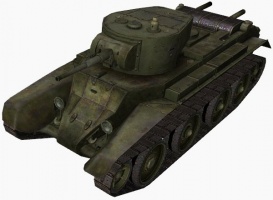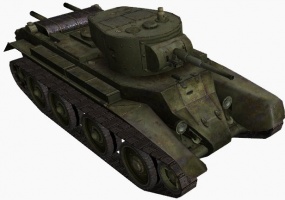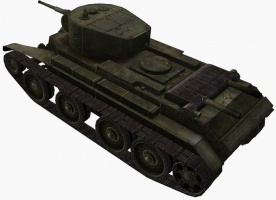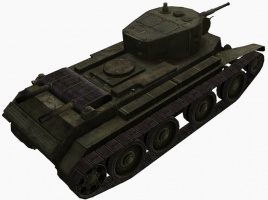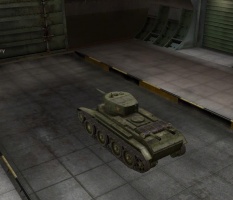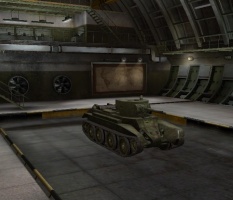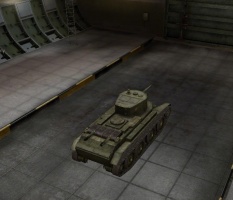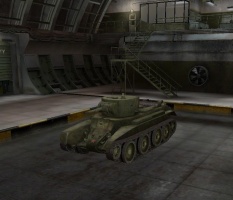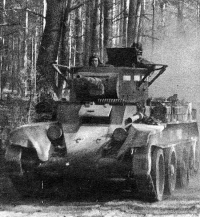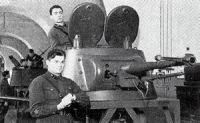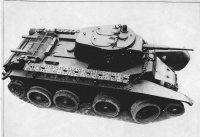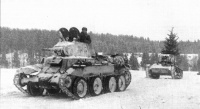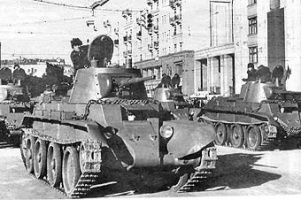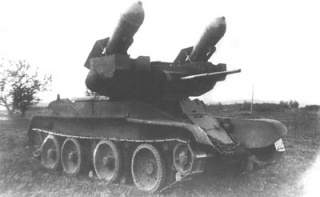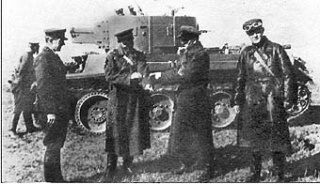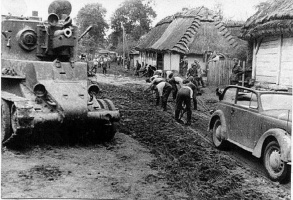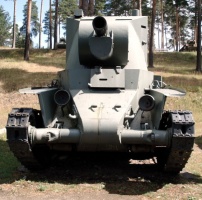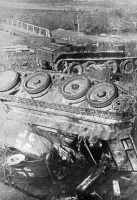BT-7
BT-7
Mouse over "
[Client Values; Actual values in
| 137,000 |
| 510108 HP Hit Points |
| 14.11/14.26.31/15.5 t Weight Limit |
- Commander (Radio Operator)
- Driver
- Gunner (Loader)
| 450480 hp Engine Power |
| 65.4/20 km/h Speed Limit |
| 4852 deg/s Traverse |
| 31.8976.07 hp/t Power/Wt Ratio |
| NoNo Pivot |
| // mm Hull Armor |
| 20/15/1520/15/15 mm Turret Armor |
AP/APCR/HE
AP/APCR/HE Shells |
14/800/14
35/800/10 Shell Cost |
| 47/47/6240/40/50 HP Damage |
| 51/88/2358/92/19 mm Penetration |
|
28.57 r/m ▲
33.33 r/m Standard Gun ▲ Rate of Fire Standard Gun |
|
1342.79 ▲
Standard Gun
▼
Standard Gun
▲
1333.2 Standard Gun ▲
Standard Gun
▼
Standard Gun
▲ Damage Per Minute Standard Gun |
|
0.44 m ▲
0.37 m With 50% Crew: 0.545 m ▲ Accuracy With 50% Crew: 0.458 m |
| 1.9 s 1.7 s Aim time |
| 3840 deg/s Turret Traverse |
| 360° Gun Arc |
| -8°/+25°-8°/+25° Elevation Arc |
| 160200 rounds Ammo Capacity |
| 2015 % Chance of Fire |
| 330 m 350 m View Range |
| 300 m 615 m Signal Range |
IV
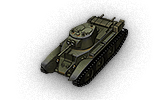
137000
The BT-7 is a Soviet tier 4 light tank.
The Soviet wheeled caterpillar tank used in the 1930s–1940s. The third vehicle in the series of the Soviet light BT tanks. The BT-7 differed from its predecessors in the welded hull of a modified shape and a new engine. A total of 5,556 vehicles of different variants were produced and saw action during the Khalkhyn Gol battles, Polish Campaign, Winter War and World War II.
The BT-7 is a decent upgrade from the BT-5, offering better stats in all areas except acceleration. It is one of the fastest tanks in the game, in exchange for very poor armor and relatively weak armament.
Modules / Available Equipment and Consumables
Modules
| Tier | Engine | Engine Power (hp) |
Chance of Fire on Impact (%) |
Weight (kg) |
Price (
| |
|---|---|---|---|---|---|---|
| V | V-2 | 480 | 15 | 750 | 18750 | |
| IV | M-17T | 500 | 20 | 610 | 13460 | |
| IV | M-17L 1,400 r/min | 450 | 20 | 610 | 10770 |
| Tier | Suspension | Load Limit (т) |
Traverse Speed (gr/sec) |
Rmin | Weight (kg) |
Price (
| |
|---|---|---|---|---|---|---|---|
| III | BT-5 | 14.2 | 48 | B/2 | 4000 | 1200 | |
| IV | BT-7 | 15.5 | 52 | B/2 | 4000 | 3400 |
Compatible Equipment
Compatible Consumables
Player Opinion
Pros and Cons
Pros:
- Excellent speed, acceleration, and maneuverability
- Low profile and good camouflage values
- ZiS-19 gun has good accuracy when on the move
- Surprisingly good for ramming
Cons:
- Paper-thin armor and below average HP
- Will not survive a face-off against higher tier tanks
- Poor damage and penetration on both weapons, made worse by its move to Tier 4
- Bad view range for a scout; passive scouting is, even against tier 5, not really an option
Performance
The BT-7 is a somewhat improved BT-5 with slightly more HP that can now face tanks up to Tier 6. It has the choice of two weapons: the 45 mm 20K gun has mediocre accuracy, fairly good penetration, and good damage, while the 37 mm ZiS-19 offers better penetration and has excellent accuracy, but a somewhat disappointing damage output.
The BT-7 excels as a raider/breakthrough exploitation tank, the role for which it was originally designed. Once it has broken through the enemy's front line, it can hunt down enemy artillery and, in skilled hands, cause a great amount of disruption and can own basically any tank tier 4 and below. The BT-7 works particularly well in combination with other BT tanks.
While adequate enough to allow the BT-7 to act as a battle tank in Tier 4 matches, all the weapons have insufficient penetration to deal with heavier tanks that the BT-7 sometimes faces. In such matches, the BT-7 is best used as a support sniper or flanker, not drawing any unnecessary attention to itself. While the BT-7 is quite capable of pulling off the circling technique against heavier tanks and tank destroyers, this should only be used against isolated enemies and with an experienced driver.
The BT-7's great speed and good camouflage also allow it to be used in the scouting role. Its superb speed will allow it to take up forward spotting positions quickly after the start of the game. However, the BT-7's view range is merely okay, though this can be remedied to an extent with the use of Binoculars, Coated Optics, and the Recon or Situational Awareness skills. The BT-7 can also be used as a counter-scout, as it has the speed and sufficient agility and firepower to intercept most enemy light tanks without too much trouble.
In addition, the blistering speed combined with rather decent mass allow ramming to be a somewhat viable option for this tank. But unless your driver has the Controlled Impact skill, this should only be done if the enemy tank has low health, and against serious threats which have a small enough mass to take serious damage from a collision.
Crew Skills
- Camouflage as the first skill on all the crew members is a good choice and is invaluable if the BT-7 is required to take up the scouting role. Repairs is not very useful, as getting tracked or having the engine damaged on the BT-7 without a repair kit is almost always fatal.
- A more specialized set of first skills would be Situational Awareness (Commander/Radio Operator), Snap Shot (Gunner/Loader), Smooth Ride (Driver). Situational Awareness provides a bigger view range bonus than Recon, and is generally superior. Snap Shot and Smooth Ride combined act like a Vertical Stabilizer (which the BT-7 does not have access to), reducing the accuracy penalties incurred while moving and rotating the turret. Due to its speed, the BT-7 has higher accuracy penalties while moving than most tanks, and this can be important in helping the BT-7 get its shot off first. Off-Road Driving is also a viable option for the driver to further augment the BT-7's excellent mobility.
- Upon reaching 100% on the first skills, dropping the commander's skill for Sixth Sense is an excellent option. Deadeye is a good perk for the gunner, especially when targeting weak spots like engines and ammunition racks. The gunner also acts as the loader, but the loader only has access to perks which are not particularly useful for the BT-7: Safe Stowage increases the HP of the ammunition rack, but the BT-7's best defence is to not take a hit at all, while the BT-7 will very rarely find itself at under 10% of its HP so that the Adrenaline Rush perk activates.
- Brothers-in-Arms is a good perk to have on any tank, but requires all crew members to have it at 100% before it works. The bonus to crew skills is particularly noticeable when combined with Improved Ventilation.
Early Research
- The 12LL radio carries over from the BT-5.
- The first priority should be the M-17T engine, which dramatically increases the BT-7's performance.
- The BT-7 suspension should be researched next for increased hull traverse speed and load limit
- The BT-7 conical turret should be researched next, followed by the 37 mm ZiS-19.
- Finally, the V-2 engine is required to unlock the A-20, but it is inadvisable to equip it; it provides 20 hp less than the M-17F and also weighs 140 kg more, significantly reducing performance. The only benefit it has over the M-17T is a 5% lower chance of catching fire when hit.
Suggested Equipment
Gallery
Historical Info
The BT-7 was the last of the BT tank series of Soviet cavalry tanks that were produced in large numbers between 1935 and 1940. They were lightly armored, but reasonably well-armed for their time, and had much better mobility than other contemporary tank designs. The BT tanks were known by the nickname Betka from the acronym, or its diminutive Betushka. BT (Russian: БТ) stands for fast tank (Быстроходный танк, Bystrokhodny tank). The successor of the BT-7 Tank would be the famous T-34 medium tank, introduced in 1940, which would replace all of the Soviet fast tanks, infantry tanks, and medium tanks then in service.
Development history
The first prototypes of the BT-7 had a distinctive canted-ellipse shaped turret mounting both the main gun and a coaxial machine-gun. The specification also called for the project to allow for installation without any significant change to the framework of new guns: the 76 mm CT or PS-3 main gun (a short-barreled howitzer) and the 45 mm 20K model 1932/38, a long-barreled, high-velocity gun useful against tanks, but less effective than the 76 mm gun against infantry.
In the rear of the turret, there was housed a rotating drum-type magazine for 18 76 mm shells or a radio station. The prototype underwent an extensive testing program in the summer and autumn of 1934. As a result of this testing, it was felt that a machine-gun was unnecessary on a tank with a 3-man crew, especially as it made the assembly of the turret more complicated.Therefore, in early 1935, the tank went into production with a simpler design, incorporating the turret from the BT-5. (However, the idea of wheeled/tracked vehicle with a 76 mm cannon was not abandoned and the plant was commissioned to develop a new BT-7 turret from the turret of the T-26-4). In the production model, a cylindrical turret housed a 45 mm 20K gun with a DT-model machine-gun. On some of the tanks, a model 71-TC radio with frame antenna was installed. The crew consisted of three men: the commander (who also served as the gunner), the loader, and the driver. In 1937, the company launched production of the BT-7 with a conical turret. Main armament remained the same, but the ammunition was increased to 44 rounds. All serving tanks now installed the DT machine gun in the rear niche. For the firing of the gun and coaxial machine gun at night, the tank was equipped with two special projector-type headlamps, and a mask placed on the gun. Subsequently, these Lights were retrofitted to earlier models of the tank. Improvements were also made to the drive wheels, caterpillar tracks, and gearbox by 1938. In parallel with the main modification, 154 BT-7A artillery tanks were produced between 1936 and 1938, fitted with a larger turret and a 76 mm CT-type gun, with 50 rounds of ammunition (40 in a tank with a portable radio). In 1938, four experimental BT-8 tanks mounted with V-2 diesel engines were produced. After comparative tests of the BT-7 and BT-8, the diesel tanks were put into production in 1940 (under the designation BT-7M) with the powerplants being produced in a separate plant of the Voroshilovets factory to ensure supply. From December 1939, the BT-7A went into production with some minor modifications; additional bracing for rigidity, a manhole underneath, and a smaller air filter. The diesel-powered tanks showed much-reduced fuel costs, and the petrol tanks were soon placed into reserve.
Several experimental tanks were conceived based on the BT series, for example: the wheeled BT-IC, designed by NF Tsyganova, a platoon commander in the 4th Armoured Regiment of the Ukraine Military District and self-taught designer. The type successfully passed field tests, but was not ordered in bulk. Another Tsyganova design was the S-2 "Turtle", with a new design of hull and turret. There was also the command tank CBT-7 with a fixed turret, the OT-7 mounting a flamethrower, the HBT-7 designed to protect from toxic contamination and lay smokescreens, the PBT bridgelayer, and the TTBT-7 and Thubten-7 radio-controlled tanks (known at the time as Teletanki). Shortly before Operation Barbarossa, the BT-7 underwent an up-armor program. In 1940, Mariupol Ilyich Iron and Steel Works produced 50 sets of hinged homogeneous armor for the BT-7M, which increased the weight of the test tank to 18 tons. On the installation of these kits to military units, unfortunately, nothing is known.
Combat history
Between 1935 and 1940, between 2700 to 5328 BT-7 tanks of all modifications (except BT-7A) were built. They were operated by the armored and mechanized forces of the Red Army for almost the entire war. Over 2000 BT-7 series tanks were lost in the first 12 months on the Eastern Front. Hundreds had been immobilized even before the invasion by poor maintenance, and had to be abandoned as all Soviet forces withdrew eastward. The survivors fought against the Wehrmacht in numbers gradually reduced by attrition, until superseded by more modern types in 1944. The BT-7 series continued in use elsewhere, including being used against Japanese forces (Battle of Khalkhyn Gol and Manchurian Strategic Offensive Operation) in Manchuria in 1945.
| BT-2 | BT-5 | BT-7 | BT-7A | BT-7M (BT-8) | |
|---|---|---|---|---|---|
| Number built | 620 | 2,108 | 4,965 | 154 | 790 |
| crew | 3 | 3 | 3 | 3 | 3 |
| weight | 10.2 t | 11.5 t | 14 t | 14.5 t | 14.7 t |
| length | 5.58 m | 5.58 m | 5.66 m | 5.66 m | 5.66 m |
| width | 2.23 m | 2.23 m | 2.29 m | 2.29 m | 2.29 m |
| height | 2.20 m | 2.25 m | 2.42 m | 2.52 m | 2.42 m |
| armour | 6–13 mm | 6–13 mm | 6–13 mm | 6–13 mm | 6–22 mm |
| main gun | 37 mm Model 30 |
45 mm Model 32 |
45 mm Model 35 |
76.2mm Model 27/32 |
45 mm Model 38 |
| main gun ammunition |
96 rounds | 115 rouds | 146 rounds | 50 rounds | 146 rounds |
| machine guns | DT | DT | DT | 2×DT | 3×DT |
| engine power model |
400 hp Liberty |
400 hp M-5 |
500 hp M-17T |
500 hp M-17T |
450 hp V-2 |
| fuel | 400 l gasoline |
360 l gasoline |
620 l gasoline |
620 l gasoline |
620+170 l diesel |
| road speed | 100 km/h (62 mph) | 72 km/h (45 mph) | 86 km/h (53 mph) | 86 km/h (53 mph) | 86 km/h (53 mph) |
| power:weight | 39 hp/t | 35 hp/t | 36 hp/t | 34 hp/t | 31 hp/t |
| road range | 300 km | 200 km | 250 km | 250 km | 700 km |
| tactical range | 100 km | 90 km | 120 km | 120 km | 400 km |
Historical Gallery
Historical Accuracy Errata
The 37 mm ZiS-19 was only developed for the T-60. Its configuration on the BT-7 is fake.
- The 23 mm VJa was only mounted on aircraft like the Il-2. Its configuration on the BT-7 is also fake.












